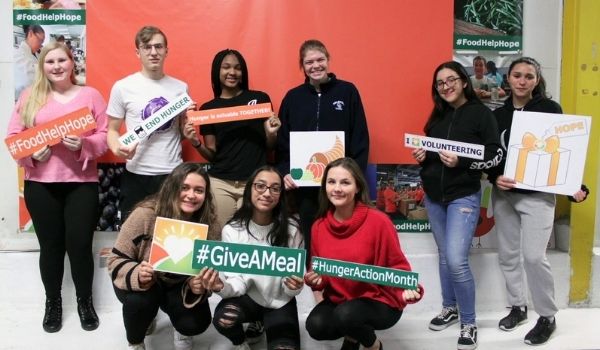
In 2021, about 200,000 food insecure children residing in New Jersey, leaving 1 in 10 children sitting in a classroom left vulnerable to hunger. Additionally, children in South Jersey counties such as Atlantic, Cape May, and Cumberland were almost twice as likely to experience hunger than the rest of the state, with 1 in 6 children being food insecure.
Though hunger remains a national and global issue, through collaborative effort, sustainable change beyond each generation is possible. The youth programs at CFBNJ are critically important, and we’ve provided some activities to teach students about what hunger can mean for an individual or family, and what anyone can do to help. We have also provided downloadable PDFs with breakdowns of each assignment.
 7 Ways to Teach Kids About Hunger
7 Ways to Teach Kids About Hunger
- Meaning of Food Activity (Grade Levels: Elementary): This activity is an exploration of the relationship between food, family, and community-, and how it has an impact on each of us individually, communally, and culturally. Through this activity, students will develop a deeper understanding of food and its vital role in human connection and their own personal lives, bringing more compassion and empathy to those who face the struggle of this absence.
- Roots of Hunger (Grade Levels: Elementary, Middle): In this activity, students are given unequal resources to learn about the unequal distribution of food and wealth gaps across the world. Through enactment and discussion, awareness about the roots of hunger and the current systems that support hunger will be increased, and students will get a better understanding of their role in a global sense.
- Marshmallow Equity Activity (Grade Levels: Middle & High School): In teams, students are given a varying and limited supply of resources to build a marshmallow structure. At the end of the activity, they will see how every team has different structures due to what resources they were initially given, opening up the discussion towards the meaning of equality and equity.
- Minimum Wage Activity (Grade Levels: All): In this hunger simulation activity, students are asked to create a monthly budget for one adult and one 3-year old based on a minimum wage income. Through breaking down each expense on a tight income-restricted budget, students will learn the challenges that come with a minimum wage salary, including the question of adjusting and forgoing necessities.
- Student Presentations (Grade Levels: All): It’s true when they say that information and knowledge are integrated deeper into our brain when we explain or teach it to someone else. Encourage students to research and learn about hunger themselves and to create a presentation on it for the class. This activity can serve as a chance for them to not only gain a better understanding of hunger through becoming the teacher, but may also spark an interest in advocacy.
- Invite guest outreach speakers from your local food pantry, or anti-hunger organizations. Having a person who specializes in food insecurity speak to students can be a great way to not only educate and open up discussion, but to expose students to possible career opportunities in advocacy. Learn more about how our team at CFBNJ can help teach kids about hunger.
- Lastly, statistics (Grade Levels: All). Statistics serve as a powerful tool in painting a clear picture of how many people face hunger. For example, when put into perspective that 1 in 12 families in New Jersey are struggling for their next meal, it is easier for people to understand that anyone could be facing this issue. It is also often the same individuals and families who struggle to afford diapers or feminine hygiene products.Through bringing awareness to how 1 in 3 families in the U.S. report facing difficulties in getting diapers and oftentimes forgo other necessities such as food, utilities, and medicine, empathy in kids is encouraged and students can grasp how food insecurity is a symptom of a larger systematic issue that can have an effect on many aspects of someone’s life.
 4 Youth Volunteer Opportunities
4 Youth Volunteer Opportunities
- Set up a field trip for students to volunteer with us. Volunteering at CFBNJ is an interactive experience for students to learn about how food banks operate in the backend. Volunteer days will be spent sorting through food, creating Kids Cafe Meals, packing Family Meals, and more.
- Register your school in Students Change Hunger, a friendly fundraising competition between schools designed to educate and encourage students to become active participants in the fight against hunger. Last year, $45,000 and over 56,000 pounds of food was donated from over 100 schools in New Jersey! This fundraising event goes until Friday, January 14, 2022 and is available to all grade levels, so make sure to sign up soon.
- Encourage students to participate in the many youth leadership programs at CFBNJ. The Community FoodBank of New Jersey offers multiple and diverse programs for students looking to refine their advocacy skills, such as the Teen Advisory Committee, Teen Leadership Council, and the Teen Leadership Institute. Leadership programs are available for students in grades 7-12 and no experience is necessary, all students will be trained from the ground up regarding fundraising, community organizing, and more.
- For older students, we recommend setting up an in-person food drive or virtual fund drive. For fun, they can get creative and align these drives with a holiday, for their birthdays, or club events! More tips and tricks on how to successfully run a food drive or virtual fund drive can be found here.
There are many ways to educate and get involved in the fight against hunger, and these are just a few. Much of what we are able to accomplish can’t be done without you! Please consider giving a monetary gift to CFBNJ today.
